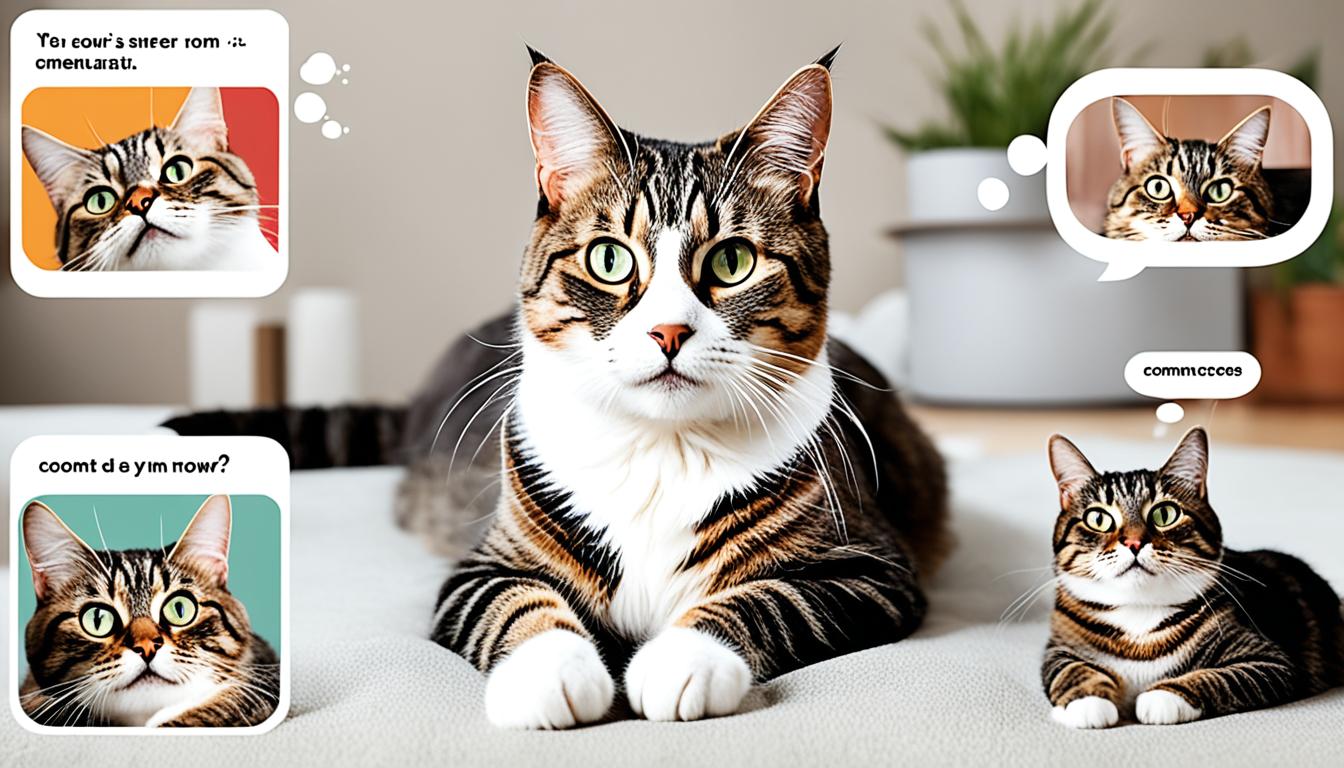Cats are mysterious creatures with a unique language all their own. They communicate through a combination of vocalizations, body postures, and daily routines. Understanding your cat’s vocalizations can provide valuable insights into their needs and emotions.
Meows are one of the most commonly recognized cat sounds. These versatile vocalizations can have different meanings depending on the context. Cats may meow to greet you, demand attention, object to something, or make announcements.
Purring, on the other hand, is often associated with contentment. It’s a soothing, rhythmic sound that cats produce when they are happy, comfortable, or seeking attention. However, purring can also be used as a self-soothing mechanism when a cat is anxious or sick.
By interpreting these vocalizations and decoding their meanings, you can better understand your cat’s behavior cues and respond accordingly. Whether it’s deciphering meows or understanding the nuances of purring, unlocking the secrets of cat language can strengthen the bond between you and your feline friend.
Key Takeaways:
- Meows serve various purposes, including greetings, commands, objections, or announcements.
- Purring is usually a sign of contentment but can also be used as a self-soothing mechanism.
- Growling, hissing, or spitting indicate annoyance, fear, or aggression.
- Yowling or howling can indicate distress or mating behavior.
- Chattering or twittering noises are often made when cats are excited or observing prey.
Interpreting Your Cat’s Meows
Meowing is a versatile vocalization used by cats to communicate with humans. Cats may meow to demand attention, food, or access to a room. The duration and pitch of the meow can vary, and different types of meows can convey different messages.
- The standard meow is commonly used to ask for something.
- The “mewl” is a shorter meow used as a greeting.
- A long, drawn-out meow often indicates a specific demand, such as wanting to be fed.
- Repeated meows are a sign of excitement.
- High-pitched meows can indicate sudden startle or pain.
- Low-pitched meows may convey complaints or a desire for something.
It is important to pay attention to the context and body language when interpreting your cat’s meows. Understanding the nuances of their vocalizations can help you respond appropriately to their needs and strengthen your bond with them.

| Meow Type | Meaning |
|---|---|
| Standard Meow | Asking for something |
| Mewl | Greeting |
| Long, Drawn-Out Meow | Specific demand, such as wanting to be fed |
| Repeated Meows | Excitement |
| High-Pitched Meows | Sudden startle or pain |
| Low-Pitched Meows | Complaints or desire for something |
Decoding Your Cat’s Purrs and Other Vocalizations
Cats possess a unique way of communicating their emotions and needs through vocalizations. One of the most well-known cat sounds is purring, which is often associated with contentment. When a cat purrs, it typically signifies that they are happy, comfortable, or seeking attention. However, it’s important to note that purring can also occur when a cat is anxious or sick, as it serves as a self-soothing mechanism.
Aside from purring, cats use various vocalizations to communicate with their owners. Chirps, trills, and chatters are common vocalizations that cats employ to express excitement or engage with their human companions. These sounds can indicate their enthusiasm or desire to interact. On the other hand, hissing and growling are defensive vocalizations that convey fear or aggression. These vocal cues can help you understand when your cat is feeling threatened or uncomfortable.
Yowling or howling is another vocalization that cats may use to convey distress, discomfort, or territorial concerns. These sounds can arise when cats are in pain, experiencing discomfort, or attempting to establish their boundaries. By paying attention to these vocalizations and becoming familiar with their meanings, you can gain a deeper understanding of your cat’s emotions and needs.
FAQ
How do cats communicate through vocalizations?
Cats communicate through various vocalizations such as meows, chirps, trills, growls, hisses, purrs, yowls, howls, chatters, and twittering noises.
What do different types of meows indicate?
Different types of meows convey different messages. A standard meow is commonly used to ask for something, while a “mewl” is a shorter meow used as a greeting. A long, drawn-out meow often indicates a specific demand, while repeated meows signify excitement. High-pitched meows can indicate sudden startle or pain, while low-pitched meows may convey complaints or a desire for something. Context and body language are important for interpreting meows.
What does purring usually signify?
Purring is often associated with contentment and can indicate that a cat is happy, comfortable, or seeking attention. However, cats can also purr when they are anxious or sick, using it as a self-soothing mechanism.
What are some other vocalizations used by cats?
Cats use chirps, trills, and chatters to communicate with their owners or express excitement. Hissing and growling are defensive vocalizations that indicate fear or aggression. Yowling or howling may signify distress, discomfort, or territorial concerns.
Why is it important to understand cat vocalizations?
Understanding cat vocalizations helps you better understand your cat’s emotions and needs. It allows you to respond appropriately to their communication and provide them with the care and attention they require.

